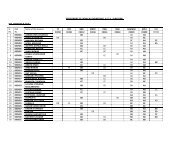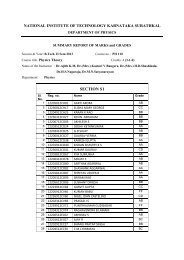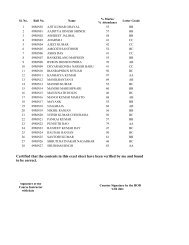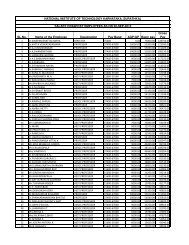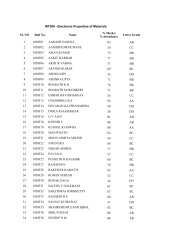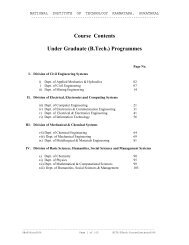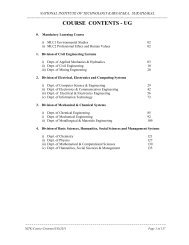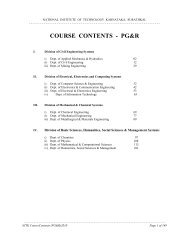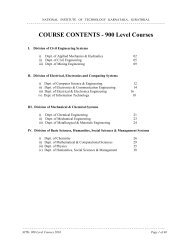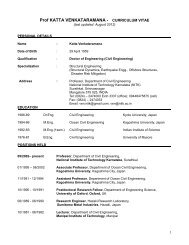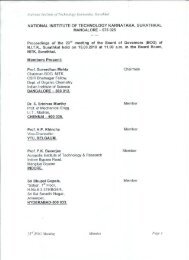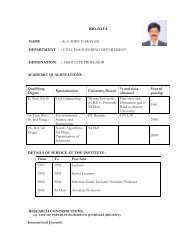course contents - ug - National Institute of Technology Karnataka
course contents - ug - National Institute of Technology Karnataka
course contents - ug - National Institute of Technology Karnataka
Create successful ePaper yourself
Turn your PDF publications into a flip-book with our unique Google optimized e-Paper software.
NATIONAL INSTITUTE OF TECHNOLOGY KARNATAKA, SURATHAKAL<br />
------------------------------------------------------------------------------------------------------------------<br />
Harmonic weights, I-T and kV-T products, Shielding. C: Biological Effects. Power Theory, Single and<br />
three phase, non-sinusoidal conditions, Fryez and Budeno�s methods. Complete survey upto date. Power<br />
Quality Parameters : Definitions . Standards for Power Quality. Transducers and Data Transmission, Hall<br />
Effect Voltage and Current Sensors, Data Transmission medium and methods, Harmonic Mitigation<br />
Techniques, Passive Filters : Design <strong>of</strong> Passive filters, DC side filters and Active Filters : Principles <strong>of</strong><br />
operation, Algorithms for Extraction <strong>of</strong> Harmonic current in the line.<br />
J. Arrillaga, Power System Harmonics, IEE Press.<br />
G. T. Heydt , Power Quality, Stars in a Circle, 1991.<br />
M. G. Say , Alternating Current Machines, ELBS.<br />
EE313 DIGITAL SIGNAL PROCESSING (3-1-0)<br />
Review <strong>of</strong> FT, DTFT, DFT. Interpreting DFT values, Frequency resolution and DFT 4 bins. Properties <strong>of</strong><br />
DFT, Limitations <strong>of</strong> DFT. Circular Convolution, DFT computation methods: Radix FFTs: Decimation in<br />
time and Decimation in frequency FFT, DCT. IIR Filters: Analog filters: Properties and Design <strong>of</strong><br />
Butterworth, Chebychev and Elliptical filters. Frequency transformation. Review <strong>of</strong> Z-transform and its<br />
properties: Structure <strong>of</strong> Digital Filters. Methods <strong>of</strong> Converting Analog Filters to Digital Filter (IIR):<br />
Approximating the Integration: bilinear transformation, pole-zero mapping, Impulse invariant<br />
transformation. FIR filters : Structure and properties <strong>of</strong> FIR filters. Methods <strong>of</strong> designing the FIR filters:<br />
Window-based methods, Frequency Sampling Method. Introduction to the programmed digital systems.<br />
General Architecture <strong>of</strong> Digital Signal Processors, Instruction set, Introduction to Programming digital<br />
systems. Example <strong>of</strong> the TMS320F243, Application <strong>of</strong> DFT for Linear filtering.<br />
John G. Proakis, D.G. Manolakis, Digital Signal Processing.<br />
Ashok Ambardar, Analog and Digital Signal Processing.<br />
L. R. Rabiner, B. Gold , Theory and Applications <strong>of</strong> Digital Signal Processing, PHI, 1975<br />
Richard G. Lyons, Understanding Digital Signal Processing.<br />
Roman Kuc , Introduction to Digital Signal Processing.<br />
A. V. Oppenheim, R. W. Schafer, Discrete-Time Signal Processing.<br />
EE319 NEURAL NETWORKS AND APPLICATIONS (3-0-0)<br />
Introduction: Structure <strong>of</strong> the human brain, Organization <strong>of</strong> the brain, Biological neuron, 3 Mc-Culloch-<br />
Pitts neuron model. Various thresholding functions, Feature vectors and feature space. Classification<br />
techniques � nearest neighbour classification. Distance metrics, Linear classifiers, Decision regions. The<br />
single layer and multilayer perception, Multilayer perception algorithm, Solution <strong>of</strong> the XOR problem,<br />
Visualizing the network behaviour in terms <strong>of</strong> energy functions, Mexican Hat function. Learning in<br />
Neural networks, supervised and unsupervised learning, Feed-forward networks, Linearly non-separable<br />
pattern classification, Delta learning rule. Error back-propagation training algorithms, Feedback networks<br />
� Hopfield network, The energy landscape, Storing patterns, Recall phase, The Boltzmann machine, The<br />
traveling salesman problem. Associative memories � basic concepts, Recurrent autoassociative memory,<br />
Retrieval and Storage algorithm, Stability considerations. Application <strong>of</strong> neural systems � Linear<br />
programming, Modeling networks, Character recognition, Control system applications, Robotic<br />
applications.<br />
R. Beale, T. Jackson, Neural Computing: An Introduction , IOP Publishing Ltd., 1990.<br />
Jack H. Zaruda, Introduction to Artificial Neural Systems , Jaico Publications.<br />
EE321 LINEAR AND NONLINEAR SYSTEMS (3-1-0)<br />
Characteristics <strong>of</strong> linear systems, Modeling and analysis <strong>of</strong> linear time-invariant systems 4 using state-space<br />
approach, Analysis <strong>of</strong> linear time-variant systems. Characteristics <strong>of</strong> nonlinear systems, Common types<br />
<strong>of</strong> nonlinearities, Phase-plane analysis, Describing function analysis.<br />
Thomas Kailath, Linear Systems, Prentice-Hall, 1980.<br />
K.Ogata, State-Space Analysis <strong>of</strong> Control Systems, Prentice-Hall, 1967.<br />
John E. Gibson, Non linear Automatic Control, McGraw-Hill, 1963.<br />
---------------------------------------------------------------------<br />
NITK-Course Contents(UG)2010 Page 59 <strong>of</strong> 134



